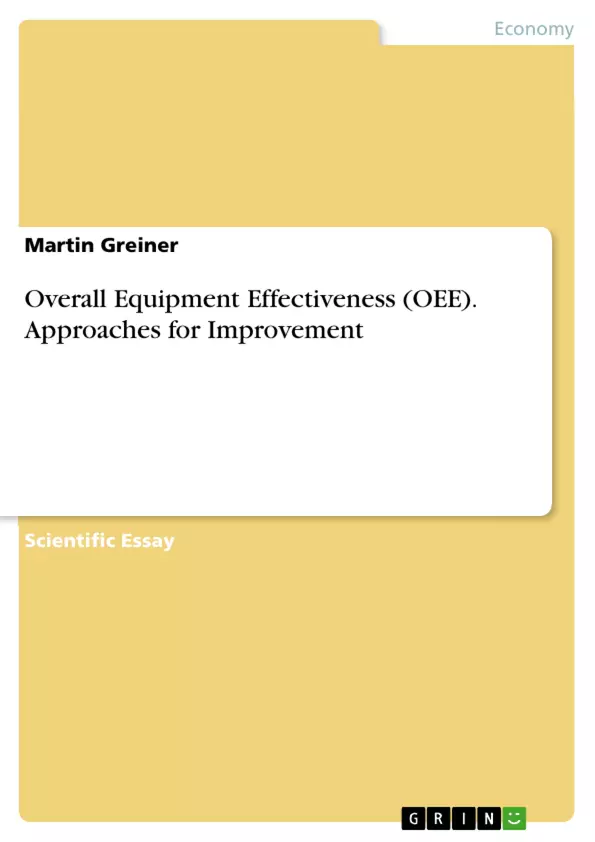Overall Equipment Effectiveness (OEE) is a ratio of the actual output over the figure it could be theoretically, and is calculated by a multiple of three components, all of which relate to actual versus theoretical values; availability, performance and quality (Lannone and Nenni, 2013). Another relevant interpretation of the acronym OEE was devised by Vijayakumar and Gajendran (2014, p. 47), providing three principles for maximising the OEE value, where O represents its objective of accomplishing organisational goal(s), E is the efficiency resulting from doing things right, and E for effectiveness which is a consequence of doing the right thing.
The major purpose of OEE is used to improve overall manufacturing production performance. The measurement demonstrates how well the production process matches the planned process, its value is reliant on the multiple of the three components, availability, performance and quality but industry average values are well below the 100% figure. In reality world class performance is regarded as and OEE value equivalent to 85%, however, in most cases the actual figure is much lower, between 60% and 70% (Lannone and Nenni, 2013). Automotive manufacturers who are able to reduce the length of manufacturing processes by as little as a few seconds can leverage productivity by one or two extra vehicles a day, generating additional revenue in the long term (Montpass, 2014).
Hence in this presentation the reasons for the gap are appraised, particularly in relation to automotive manufacturing. Initially an overview of each of the components and the factors that most negatively impact on the OEE value are provided, followed by the most up to date interventions that are being employed to improve OEE. In an industry in which consumption is declining (Marketline, 2015) and competition for sales increasingly fierce, the OEE value is vital to productivity and competitive advantage.
Inhaltsverzeichnis (Table of Contents)
- Introduction
- The Reasons for Low OEE Values
- Interventions to Improve OEE
- Industrial Internet
- Cloud and SaaS Solutions
- Conclusion
Zielsetzung und Themenschwerpunkte (Objectives and Key Themes)
This presentation explores the concept of Overall Equipment Effectiveness (OEE), its importance in enhancing manufacturing performance, and the factors that contribute to its decline. The paper focuses particularly on the automotive industry, examining the challenges and opportunities in achieving optimal OEE within this sector.
- Factors influencing OEE, particularly in automotive manufacturing.
- Strategies and interventions for improving OEE.
- The role of the Industrial Internet in optimizing OEE.
- The importance of employee preparedness and knowledge in OEE improvement.
- The impact of changing customer preferences and model upgrades on OEE.
Zusammenfassung der Kapitel (Chapter Summaries)
- Introduction: This chapter introduces the concept of OEE, defining it as a ratio of actual output to theoretical output. It discusses the importance of OEE in improving manufacturing performance and highlights the significant gap between theoretical and actual OEE values, especially in the automotive industry.
- The Reasons for Low OEE Values: This chapter identifies six key factors that contribute to lower OEE values, including downtime, production issues, and quality issues. It emphasizes the impact of downtime losses resulting from breakdowns, setups, and machine wear on OEE.
- Interventions to Improve OEE: This chapter discusses various interventions aimed at improving OEE, focusing on the concept of Overall Equipment Effectiveness of a Manufacturing Line (OEEML). It highlights the benefits of OEEML in identifying root causes of inefficiencies and detecting their location.
- Industrial Internet: This chapter explores the potential of the Industrial Internet in addressing OEE challenges. It emphasizes the role of intelligent machines, powerful analytics, and the connection between people and machines in driving up OEE values. The chapter also highlights the potential benefits of data analytics and machine learning in improving operational efficiency and reliability.
Schlüsselwörter (Keywords)
Overall Equipment Effectiveness (OEE), automotive manufacturing, production efficiency, downtime, quality issues, Industrial Internet, intelligent machines, data analytics, employee preparedness, model upgrades, customer preferences.
- Quote paper
- Dipl.-Ing. Martin Greiner (Author), 2015, Overall Equipment Effectiveness (OEE). Approaches for Improvement, Munich, GRIN Verlag, https://www.grin.com/document/311310



